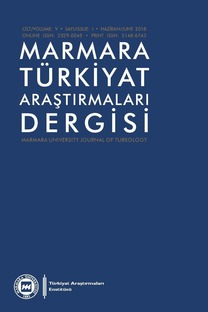Oryantalistlerin Buluşma Noktası Olarak İstanbul: Üç Oryantalist'in Gözünde Doğu / İstanbul as a Meeting Point of Orientalism and Orientalists
İstanbul sahip olduğu coğrafi konumu ile tarih boyunca hep ilgi odağı olmuştur. Bu yüzden daima dış saldırılara da açık olmuştur. Ancak bu şehir sadece iki büyük imparatorluğa, Bizans ve Osmanlı imparatorluklarına başkentlik etmiştir. Bu da asırlarca istikrarlı bir kent olmasını sağlamıştır. Bizans asırlarında Roma’nın rakibi olmasıyla Batılıların ilgisini çekmiştir. Osmanlıların fethinden sonra ise gelişmiş bir Doğu başkenti olması hasebi ile yine cazibe merkezi olmaya devam etmiştir. Oryantalizmin başlangıç tarihi hakkında farklı fikirler bulunmaktadır. Kanaatimizce bu tarihi, İstanbul’un batılı bir uygarlığın uzantısı iken Osmanlılar ile birlikte Doğu uygarlığını temsil etmeye başladığı tarihe kadar indirmek mümkündür. Yani Osmanlıların İstanbul’u fethettiği tarihi oryantalizmin de başlangıcı saymak abartılı olmasa gerektir. İlk oryantalistlerin de Bizans İstanbulu’ndan Avrupa’ya göç eden bilginlerin olduğunu varsaymak mümkündür. Aslında onlar Avrupa’ya göç ettiklerinde kendi şehirlerinden söz ediyorlardı. Ama Avrupa için burası artık Doğu medeniyetinin eline düşmüş bir kent idi. Tarih boyunca pek çok Batılı gezgin, meraklı ve maceraperestin yolu İstanbul’dan geçmiştir. Onlar yüzlerce seyahatname yazarak kendi gözleri ile doğuyu anlatmışlardır. Bu yüzden Batılıların gözünde Doğuyu anlamanın belki de en yaygın yolu bu seyahatnamelerin okunmasından geçer. Fakat bunların oryantalizmi ne kadar temsil ettikleri tartışmalıdır. Bu makalede genel olarak İstanbul’u ziyaret eden gezginlerden bahsedildikten sonra, İstanbul’da uzun süreyaşayan üç oryantalistten söz edilecektir. Alman-Avusturya oryantalizmini temsil eden Joseph von Hammer (1774-1756), İngiliz oryantalizmini temsil eden Sir James William Redhouse (1811-1892) ve Fransız oryantalizmini temsil eden Pierre Loti (1850-1923) ele alınarak, onların gözünden Doğuya bakılacaktır.
Anahtar Kelimeler:
İstanbul; Oryantalizm; Joseph von Hammer; Sir James William Redhause; Pierre Loti
-
Throughout history Istanbul has always attracted attention because of its geographical position. That’s why it has also been open to external attacks. But this city has served as a capital for only two empires: Byzantium and the Ottomans. This fact provided for Istanbul to be a stable city for centuries. Istanbul was a focus of interest for the Westerners in the Byzantium for centuries because it was a rival of the Roman Empire. It continued to be a focus of interest after the conquest by the Ottomans because of the fact that it became a developed eastern capital. There are various opinions about the beginning dates of Orientalism. In my opinion it is possible to backdate it, when Istanbul as an extent of the Western civilization started to represent the eastern civilization with the Ottomans. In other words it is possible to assume that the conquest of Istanbul by the Ottomans was the beginning date of Orientalism. It is also possible to assume that the first orientalists were the scholars who migrated from Byzantium Istanbul to Europe. Actually they were mentioning their own city but for the Europeans Istanbul was a city that fell into the hands of the eastern civilization. Throughout history many western travelers happened to pass Istanbul. They have explained the East with their own words by writing hundreds of travel books. Therefore in the eyes of the Westerners understanding the East is possible by reading these travel books. But the representation of Orientalism by these books is a problematic issue. In this article, after mentioning the travelers in general who visited Istanbul, the three orientalists who lived in Istanbul for a long time are going to be discussed. Joseph von Hammer who represents the German-Austrian orientalism, Sir James William Redhouse who represent the British orientalism, and Pierre Loti who represents the French orientalism are going to be analyzed and the article is going to look to the east through their eyes
___
- Baldıran, Galıp, “Pierre Loti’nin Aziyade’sinde Osmanlı Başkentine Tarihsel Bir Bakış”, Hacettepe Üniversitesi Edebiyat Fakültesi Dergisi, XVII/1, s. 17-25.
- Baykal, Bekir Sıtkı, “Hammer’in Hatıratı”, Dil ve Tarih Coğrafya Fakültesi Dergisi, I/1, Ankara 1946, s. 131.
- Bilgegil, M. Kaya, “Türkiye’nin Londra’daki İlk Talebe Müfettişi Redhouse’dur”, Kubbealtı Akademi Mecmuası, IV/4, İstanbul 1975, s. 22-26.
- Findley, Carter V., “Sir James W. Redhouse (1811-1892): The Making of A Perfect Orientalist?”, Journal of the American Oriental Society, XCIX/4, New Haven 1979, s. 573-600.
- Demircioğlu, Cemal, “Aziyade ve Hamam’da Doğu’nun Kurgulanışı”, Toplumsal Tarih, Ocak 2000, s. 34-47.
- Doukas, Decline and Fall of Byzantium to the Ottoman Turks, Translation, Harry J. Magoulias, Detroit, 1975.
- Ersöz, Faruk, “Güdümlü Bir Yazar Olarak Pierre Loti”, Toplumsal Tarih, Ocak 2000, s. 8-16.
- Hammer, Joseph von, Constantinopolis und der Bosporus, Pesth 1822.
- Koloğlu, Orhan, “Türkçe Öğretmeni Zeki Maghamez’in Kaleminden Pierre Loti”, Toplumsal Tarih, Ocak 2000, s. 27-29.
- Marchand, Suzanne L., German Oriantalism in the Age of Empire: Religion, Race and Scholarship, Washington 2009, s. 119.
- Melville Jones, J. R., 1453 İstanbul Kuşatması (çev. Cengiz Tomar), İstanbul 2008.
- Meriç, Cemil, “Dilimizin En Büyük Lügat-Nüvisi Redhouse”, Türk Edebiyatı, S. 100, Şubat 1982, s. 4.
- Ortaylı, İlber, “Hammer-Purgstall”, TDV İslam Ansiklopedisi, XV, İstanbul 1997, s. 491.
- (Ed.) Salahaddin el Müneccid, El Musteşrikun el Alman, C. 1, Beyrut 1978.
- Schimmel, Annemarie, “Ein Unbekantentes Werk Josph Von Hammer-Purgstalls”, Die Welt Islams XV, 1-4, Leiden 1974, s. 129-145.
- Tevetoğlu, Fethi, “Yûsuf b. Hammer”, Hayat Tarih Mecmuası, XI/12, 1 Aralık 1975, s. 12-14.
- Ünver, A. Süheyl, “Hammer’in Kitapları ve Mühürleri”, Hayat Tarih Mecmuası, V/9, 1 Ekim 1969, s. 19-20.
- ISSN: 2148-6743
- Yayın Aralığı: Yılda 2 Sayı
- Başlangıç: 2014
- Yayıncı: Marmara Üniversitesi
Sayıdaki Diğer Makaleler
Tsentralnaya aziya v sostave rossiyskoy imperii [Rus İmparatorluğu Terkibinde Merkezi Asya]
Selçuk-nâme -İndeksli Tıpkıbasım
Büyük Selçuklu Sultanlarına Ait Farsça Şiirler / Persian Poems of Saljuq Sultans
MOSUL & ALEPPO GOVERNOR IMAD AL-DIN ZANGI’S FIGHT AGAINST THE CRUSADERS
Katavân Savaşı'nda Karlukların Rolü / The Role of Karluks in the Battle of Qatawān
